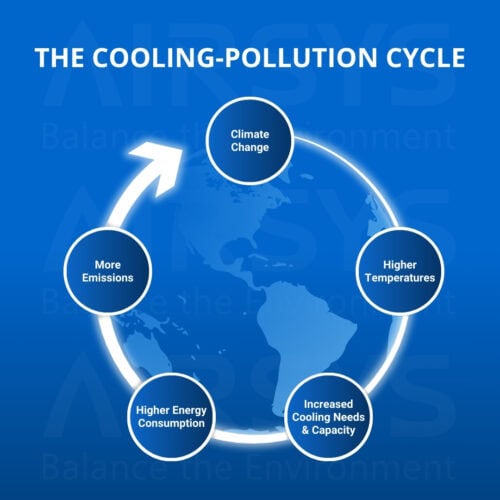
5 Reasons to Choose AIRSYS’s School Air Cooling Solutions
November 21, 2024
How Data Centers and Telecom Infrastructure Keep Us Close This Holiday Season
December 10, 2024The telecommunications industry finds itself in a paradoxical position around climate change. As one of the most energy-intensive industries globally, telecom networks and infrastructure significantly contribute to greenhouse gas emissions that drive global warming. At the same time, reliable connectivity is an essential lifeline during extreme weather events — events that are intensified, in part, by the industry’s own emissions. Cooling systems, in particular, are under pressure as rising temperatures drive up energy demands, further fueling emissions in a challenging cycle.
This article explores how telecom cooling systems navigate this dichotomy, presenting some real-world examples of thoughtfully designed cooling solutions.
The Threefold Challenge for Telecom Cooling Systems
As climate change intensifies, telecom cooling systems face unprecedented challenges threatening their efficiency and reliability:
Increasing Overheating Risks
In January 2024, NOAA (the National Oceanic and Atmospheric Administration) confirmed that 2023 was the hottest year since 1850 — putting immense pressure on telecom systems and, even more so, on their cooling needs.
As outside temperatures rise, telecom equipment must work harder, generating excessive heat. This affects both equipment housed in enclosures (like power supplies, amplifiers, and batteries), where heat buildup is significant, and outdoor infrastructure, such as junction boxes and fiber optic cables, which are highly susceptible to temperature fluctuation. This thermal stress requires higher cooling capacities than ever to maintain the smooth operation of telecommunications systems.
Free Cooling Limitations
Many telecom cooling systems rely on free cooling, which leverages naturally cooler outdoor air to reduce or eliminate the need for energy-intensive mechanical chillers. However, climate change is undermining the effectiveness of free cooling in several critical ways.
Extreme outdoor temperatures (hot or cold) compromise the system’s ability to adequately cool telecom infrastructure. Additionally, changes in air quality, humidity levels, and airflow patterns due to climate change further degrade the quality and stability of free cooling. When these natural cooling resources fail to meet the needs of telecom equipment, the cooling systems are forced to work harder, potentially leading to equipment overuse, component failures, and service interruptions.
The Cooling-Pollution Cycle
The increased cooling demands by rising global temperatures create a concerning feedback loop: Climate change drives higher global temperatures, which in turn escalates the cooling demands for telecom systems. As cooling systems work harder to meet these demands, they consume more electricity, much of which is generated from fossil fuels, leading to greater greenhouse gas emissions and higher global warming potential. These emissions then contribute back to climate change, keeping this vicious cycle rolling.

Essential Components of Climate-Resilient Cooling Systems
With the growing pressures of climate change on telecom infrastructure, cooling systems must evolve to meet new cooling demands and operate effectively in extreme conditions. Three key components are essential for building climate-resilient cooling solutions:
Energy Efficiency Solutions
Enhancing the energy efficiency of telecom cooling systems is crucial to minimizing their environmental impact. Some features can be installed to achieve this goal. For instance, advanced heat exchange technologies play a significant role here, enabling more effective heat transfer with less energy use. Smart cooling management systems, like logic-based controls, continuously monitor indoor and outdoor conditions and optimize free cooling. Lastly, power usage optimization techniques, such as variable-speed fans and two-speed motors, help adapt cooling capacity in line with real-time cooling needs.
System Durability and Quality
Telecom cooling systems must be built with durability in mind to withstand the extreme conditions driven by climate change. This approach includes balancing robust machine engineering principles and access to all critical components for maintenance and servicing, which together improve the system’s durability and longevity. Also, the incorporation of high-quality, heat-resistant components reduces the frequency of repairs and replacements, leading to other added benefits such as cost savings and the reduced environmental impact of frequent component turnover.
Sustainable Cooling Technologies
The final pillar of climate-resilient telecom cooling lies in the adoption of green, renewable-powered solutions. Integrating renewable energy sources, utilizing hybrid cooling approaches, transitioning to green refrigerants, and implementing heat recovery systems all work to minimize the carbon footprint of cooling infrastructure. These sustainable cooling technologies are critical for breaking the dangerous feedback loop between rising energy demands and accelerating climate change.
Integrating Essential Components in Telecom Cooling Systems
To demonstrate how the essential components are integrated into real-world telecom cooling systems, let’s look at AIRSYS’s innovative solutions. Our suite of cooling technologies exemplifies the key features discussed earlier. Below are three main highlights of each of our telecom cooling systems.
- EC fans reduce energy use by 30-40%.
- Robust and durable construction ensures long-lasting performance.
- Simple, unobstructed access to all key components facilitates preventive maintenance and servicing.
- Versatility in cooling capacities, from 7kW up to 240kW.
- High-quality components trusted by mission-critical businesses worldwide.
- Green cooling technologies and energy-saving design minimize environmental impact.
- Versatile cooling capacities, ranging from 20~640kW in blocks of 16.
- Equipped with a built-in NetOne platform featuring AI capabilities.
- High-quality parts and remarkable ease of use.
- 80% less coolant compared to traditional immersion cooling systems.
- A green cooling technology, recovering 100% of energy from IT equipment
- Incorporates two high-performance pumps and a heat exchanger for reliability.
Future-Proofing Telecom in a Warming World
Climate change will likely continue to pose significant challenges for the telecom industry in general, and its cooling solutions in particular. What’s worse is that as the telecom sector grapples with these climate-related issues, the environmental crisis is expected to intensify. Yet, the adoption of well-designed cooling systems can mitigate this burning crisis.
At AIRSYS we’re on a mission to balance the environment, integrating sustainable practices into our operations. Our innovative and eco-friendly cooling solutions reflect this commitment. Contact us today to discover how we can help future-proof your telecom infrastructure.



